
Circles class 9 theorems
Circles of Class 9
THEOREM9:
The sum of either pair of opposite angles of a cyclic quadrilateral is 180o.
Given :A cyclic quadrilateral ABCD.
To Prove :∠A + ∠C = ∠B + ∠D = 180 o
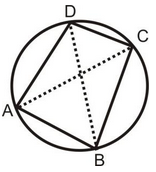
Construction :Join AC and BD.
Proof : ∠ACB = ∠ADB [Angles of same segment]
And ∠BAC = ∠BDC [Angles of same segment]
∴ ∠ACB + ∠BAC = ∠ADB + ∠BDC =∠ADC.
Adding ∠ABC to both sides, we get
∠ACB + ∠BAC + ∠ABC =∠ADC + ∠ABC.
The left side being the sum of three angles of ΔABC is equal to 180 o .
∴ ∠ADC + ∠ABC = 180 o
i.e., ∠D + ∠B = 180 o
∴ ∠A + ∠C = 360 o –(∠B + ∠D) = 180 o [∴∠A + ∠B + ∠C + ∠D = 360 o ]
Hence Proved.
Corollary :If the sum of a pair of opposite angles of a quadrilateral is 180o, then quadrilateral is cyclic.
question 15 In figure, ∠ABC = 69 o , ∠ACB = 31 o , find ∠BDC.
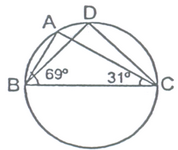
Solution: In ΔABC.
∠BAC + ∠ABC + ∠ACB = 180o
[Sum of all the angles of a triangle is 180 o ]
⇒ ∠BAC + 69 o + 31 o = 180 o
⇒ ∠BAC + 100 o = 180 o
⇒ ∠BAC = 180o– 100o = 80o
Now,∠BDC = ∠BAC = 80 o .
Ans.[Angles in the same segment of a circle are equal]
question 16 ABCD is a cyclic quadrilateral whose diagonals intersect at a point E. If ∠DBC = 70o, ∠BAC is 30 o , find ∠BCD. Further, if B = BC, find ∠ECD.
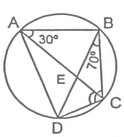
Solution: ∠CDB = ∠BAC = 30o ...(i) [Angles in the same segment of a circle are equal]
∠DBC = 70o ....(ii)
In ΔBCD,
∠BCD + ∠DBC + ∠CDB = 180 o [Sum of all he angles of a triangle is 180 o ]
⇒ ∠BCD + 70 o + 30 o = 180 o [Using (i) and (ii)]
⇒ ∠BCD + 100 o = 180 o
⇒ ∠BCD = 180 o – 100 o
⇒ ∠BCD = 80 o ...(iii)
In ΔABC,
AB = BC
∴ ∠BCA = ∠BAC = 30 ...(iv)[Angles opposite to equal sides of a triangle are equal]
Now,∠BCD = 80 o [From (iii)]
⇒ ∠BCA + ∠ECD = 80 o
⇒ 30o + ∠ECD = 80 o
⇒ ∠ECD = 80 o – 30 o
⇒ ∠ECD = 50 o
question 17 In the given figure, chord ED is parallel to the diameter AC of the circle. If ∠CBE = 650, then the value of ∠DEC is
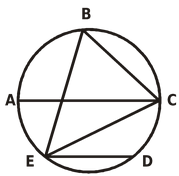
(a) 350 (b) 550 (c) 450 (d) 250
Solution: ∠EAC = ∠EBC = 650 (Angles in the same segment are equal)
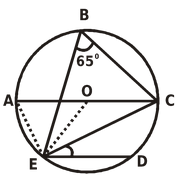
∠AEC = 900 (Angles in the semicircle)
In ∆ AEC, ∠EAC + ∠AEC + ∠ACE = 1800
650 + 900 + ∠ACE = 1800 ⇒∠ACE = 250
∠DEC = ∠ACE = 250 (∠DEC and ∠ACE are alternate angles as AC parallel to ED)
question 18 If the nonparallel side of a trapezium are equal, prove that it is cyclic.
Solution: Given :ABCD is a trapezium whose two non-parallel sides AB and BC are equal.
To Prove :Trapezium ABCD is a cyclic.
Construction :Draw BE ║ AD.
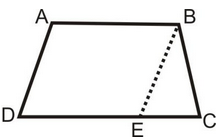
Proof: ∴ AB ║ DE [Given]
AD ║ BE [By construction]
∴ Quadrilateral ABCD is a parallelogram.
∴ ∠BAD = ∠BED ....(i) [Opp. angles of a║gm]
And,AD = BE ....(ii) [Opp. sides of a ║gm]
But AD = BC ...(iii) [Given]
From (ii) and (iii),
BE = BC
∴ ∠BEC = ∠BCE ....(iv) [Angles opposite to equal sides]
∠BEC + ∠BED = 180 o [Linear Pair Axiom]
⇒ ∠BCE + ∠BAD = 180 o [From (iv) and (i)]
⇒ Trapezium ABCD is cyclic.
[∴If a pair of opposite angles of a quadrilateral 180o, then the quadrilateral is cyclic]
Hence Proved.
question 19 Prove that a cyclic parallelogram is a rectangle.
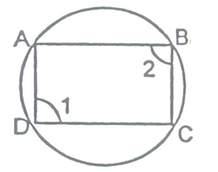
Solution: Given :ABCD is a cyclic parallelogram.
To Prove :ABCD is a rectangle.
Proof :∴ ABCD is a cyclic quadrilateral
∴ ∠1 + ∠2 = 180 o ....(i)
[∴Opposite angles of a cyclic quadrilateral are supplementary]
∴ ABCD is a parallelogram
∴ ∠1 = ∠2 ...(ii) [Opp. angles of a || gm]
From (i) and (ii),
∠1 = ∠2 = 90 o
∴ ||gm ABCD is a rectangle. Hence Proved.




